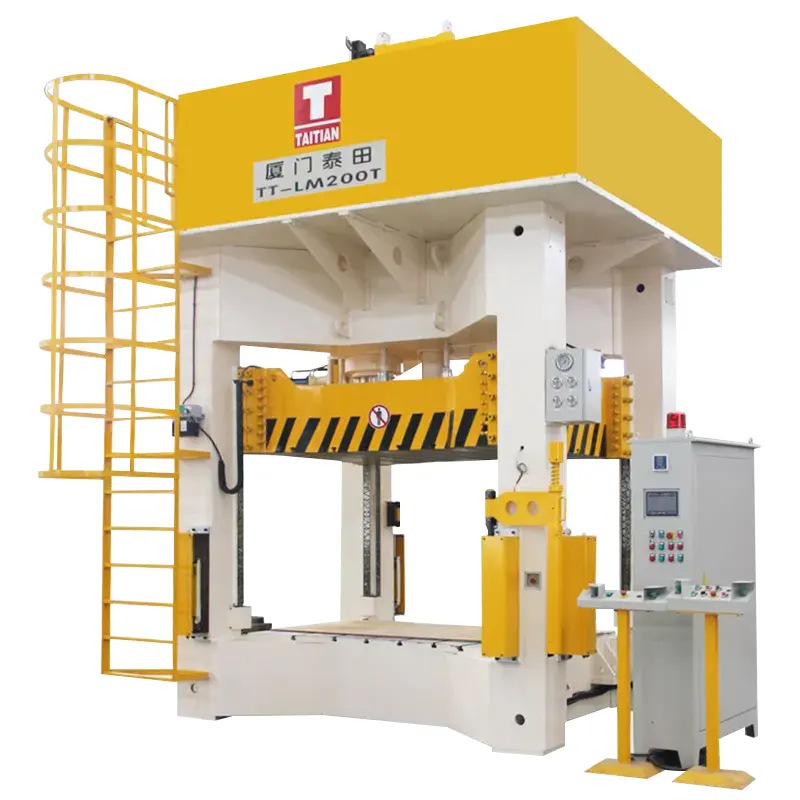Features of Automobile Interior Trim Parts Hydraulic Presses
2024-07-15
An automobile interior trim parts hydraulic press is a specialized machine used in the automotive manufacturing industry for forming and shaping various interior trim components. These hydraulic presses are crucial for producing parts that contribute to the aesthetic appeal, functionality, and comfort of a vehicle's interior. Here’s an overview of this equipment, its functions, features, and its role in automotive production:
Functions and Applications
1. Forming and Shaping:
- Purpose: Hydraulic presses are used to mold and shape interior trim parts such as door panels, dashboard components, console covers, and seat structures.
- Materials: They can work with a variety of materials including plastics, composites, and sometimes metals depending on the part requirements.
2. Precision and Control:
- Hydraulic System: Utilizes hydraulic power to exert high-pressure forces evenly across large surfaces, ensuring precise shaping and forming of parts.
- Die Sets: Customized die sets are used to achieve specific shapes and designs according to automotive design specifications.
3. Automation and Efficiency:
- Automated Processes: Some presses incorporate automation for feeding materials, positioning dies, and ejecting finished parts, enhancing efficiency and consistency in production.
- Production Speed: Capable of high production speeds, contributing to overall manufacturing throughput.
4. Versatility and Customization:
- Tooling Flexibility: Hydraulic presses can accommodate various tooling setups to produce a wide range of interior trim parts with different shapes, sizes, and textures.
- Modularity: Modular designs allow for quick changeovers between different part configurations, minimizing downtime and increasing production flexibility.
Features of Automobile Interior Trim Parts Hydraulic Presses
1. Capacity and Force:
- High Pressure: Designed to generate significant force to shape and form materials effectively.
- Ton Capacity: Typically rated by tonnage capacity, ranging from tens to hundreds of tons depending on the application.
2. Control Systems:
- Precision Controls: Equipped with advanced control systems for monitoring and adjusting parameters such as pressure, speed, and temperature.
- Safety Features: Integrated safety mechanisms ensure operator protection during operation.
3. Structure and Design:
- Heavy-Duty Construction: Built with a robust frame and components to withstand continuous use in industrial environments.
- Platen Size: Large platen sizes to accommodate various part sizes and tooling setups.
4. Energy Efficiency:
- Energy-Saving Features: Some models incorporate energy-efficient systems to optimize power consumption and reduce operational costs.
5. Maintenance and Serviceability:
- Accessibility: Designed for ease of maintenance with accessible components and service points.
- Longevity: Built for durability and reliability, requiring minimal downtime for maintenance.
Considerations for Selection
1. Part Complexity and Size:
- Match: Select a hydraulic press that can accommodate the size and complexity of the interior trim parts being produced.
2. Material Compatibility:
- Material Handling: Ensure the press is suitable for the materials (e.g., ABS plastics, fiberglass, leather) used in automotive trim parts.
3. Production Volume:
- Capacity: Choose a press with adequate capacity to meet production volume requirements without compromising on quality or efficiency.
4. Automation Needs:
- Level of Automation: Determine the level of automation needed (e.g., manual, semi-automated, fully automated) based on production goals and budget.
5. Safety and Compliance:
- Regulatory Standards: Ensure the press meets relevant safety and regulatory standards (e.g., CE certification) for industrial machinery.
Leading Manufacturers
1. Schuler Group: Known for innovative hydraulic press solutions for automotive and industrial applications.
2. Beckwood Press: Provides custom hydraulic presses tailored to specific manufacturing needs, including automotive components.
3. Sutherland Presses: Offers a range of hydraulic and mechanical presses suitable for automotive part manufacturing.
4. Fagor Arrasate: Provides hydraulic press solutions with advanced control systems and automation capabilities.
5. Komatsu America Industries: Offers high-performance hydraulic presses for automotive and other industrial applications.
Conclusion
An automobile interior trim parts hydraulic press is essential in the manufacturing process of vehicle interiors, providing the capability to mold and shape various components with precision and efficiency. By selecting the right hydraulic press based on production requirements, material compatibility, and automation needs, automotive manufacturers can enhance production capabilities and maintain high-quality standards in interior trim part manufacturing.



